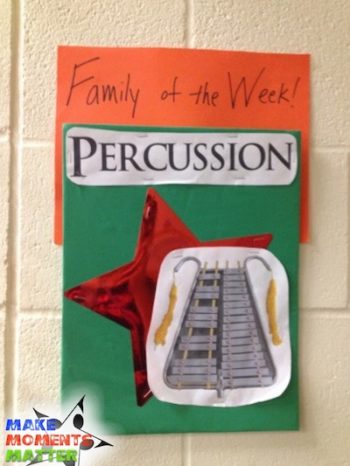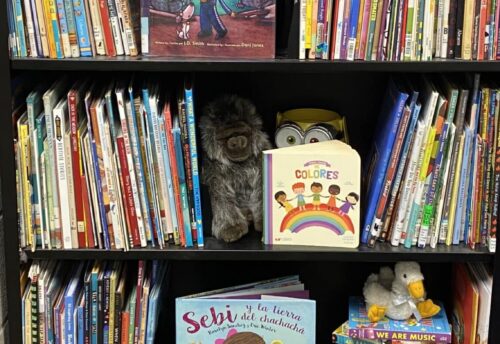
Instrument Families for Classroom Management
My first few years of teaching I really struggled with certain aspects of classroom management. I was forever losing instruction time as I spent precious minutes trying to put kids into groups and organize teams for games or small group work. And then one day I stumbled onto this idea and it has changed the way that I teach and streamlined a lot of classroom management practices.
At the end of my first year of teaching I was trying to figure out how I could easily separate my classes into groups or teams that we could use over and over. I wanted to have pre-set teams or small groups but didn’t know how I should separate students in a way that made sense and was easy to integrate with content. I tried off and on to do the “stick pick” where you put each kids name on a stick or index card and then use that item to sort kids into groups, but that took too long and didn’t always yield stable groups. I wanted something that was fast and easy and made transitions simple. I wanted a way to make more permanent groups in each class that I could use over and over, but how to do that? How could this happen without taking a lot of prep time or causing a lot of stress for me and the kids?
Making Four Teams – The Instrument Families
Eventually I decided that I needed to just separate each class into smaller teams that we would use over and over. I wavered on how many teams to use for each class. I eventually decided that four teams would give me roughly 6-8 students in each small group and that that might be the ideal size for the sorts of games and centers that I wanted to run. If I needed something larger I could put two of the four teams together giving me 2 mega groups. If I needed smaller teams I could divide each group in half and get 8 smaller groups. I also realized that I could easily name the teams after the four instrument families. The ability to teach content while reinforcing the classroom management really sealed the deal for me.
Each kid of every class would be assigned to either brass, woodwinds, strings, or percussion and would stay with that family all year long. For the first week spend a good deal of time learning who was in our family, what the family name represented, and playing games with other family members. We did things to help them identify what their family looked like and who other members were.
So, how did I separate kids into groups? At the beginning of the year I would sit down and do some intensive planning as I separated kids into the four families. I was careful to put high achieving and low achieving and behavior issues in each group so that not one group was higher achieving or filled with problems. Sometimes I just had to make my best guess about who would work well together. If part-way through the year things seemed to not be working or families were arguing among themselves, I would move a kid or two from one team to another and that usually solved the issue.
If there ever was a reason that I had one student who had extra special issues, would need the most help, or might cause problems I made sure to put them in percussion. That way, no matter what class I had, I knew that I would need to check in on percussion the most. This also helped in case I had paraprofessionals in the room shadowing a specific student. I knew that they could hang out with percussion and also (when I prepped for programs) I knew where to put that family so that the paras could easily stand next to them and help them out.
Using the Families Day-to-day
 I used the families every day for things like making groups and organizing space in the classroom. For instance, if we’re doing small group work, rotating through centers, or some other intensive activity I’ll often break the class into their families to work together. Using the families for this purpose is nice because then kids can rotate through/work with a small group of kids that they’re accustomed to and have worked previously with. Sometimes I’ll use the groups for assessment and say, “Brass family come up here and I’ll listen to you together.” If I need two groups I’ll say, “brass and woodwinds are together and percussion and strings are together.” If we’re doing something with movement I can say, “brass family members find a partner from the woodwinds family” When we prepare for our programs I have four rows on my risers so I’ll put one family on each row. Strings goes on the top row, brass on the next row, percussion on the next row and woodwinds on the bottom. They stand with their family and that repetition and reuse of the families makes sense to them and helps organize for me.
I used the families every day for things like making groups and organizing space in the classroom. For instance, if we’re doing small group work, rotating through centers, or some other intensive activity I’ll often break the class into their families to work together. Using the families for this purpose is nice because then kids can rotate through/work with a small group of kids that they’re accustomed to and have worked previously with. Sometimes I’ll use the groups for assessment and say, “Brass family come up here and I’ll listen to you together.” If I need two groups I’ll say, “brass and woodwinds are together and percussion and strings are together.” If we’re doing something with movement I can say, “brass family members find a partner from the woodwinds family” When we prepare for our programs I have four rows on my risers so I’ll put one family on each row. Strings goes on the top row, brass on the next row, percussion on the next row and woodwinds on the bottom. They stand with their family and that repetition and reuse of the families makes sense to them and helps organize for me.
This system also helps me out with classroom management and makes little things a little easier. When we line up I can say something like, “Percussion may line up first, then brass..” and it gives me an orderly and quick way to line up. Or I might say, “whichever family has the harp in it may line up first, then the family that has the recorder in it…” Of course this way I always have one family that will tell me that “you always call us last!” Often I’ll say something like, “well I’m calling the quietest family first…” and often that will quiet them down and make them reassess how they’re doing. I don’t know if it’s true that I tend to say one family more than another, but I found a way around that. Each week I post a “family of the week” and that family changes on a four week rotation so that at least once in every four weeks a family will not be last but will be first, for sure!
 Edit: I recently put colored tape on my ceiling in four different colors that match the instrument families posters/flags that I’ve created for my classroom. The tape on the ceiling is great for a lot of things (it really helps kids with folk dancing as I can say “line up under the blue line facing your partner under the red line). When it’s time to line up, each family has their own line. This means that I have four relatively short lines to monitor as opposed to one really long line where the kids int he back goof off because they don’t feel like they’re being monitored. It also means I can use the instrument families to play the kids against one another with a quick statement like “I’m going to let the quietest family walk out first…”
Edit: I recently put colored tape on my ceiling in four different colors that match the instrument families posters/flags that I’ve created for my classroom. The tape on the ceiling is great for a lot of things (it really helps kids with folk dancing as I can say “line up under the blue line facing your partner under the red line). When it’s time to line up, each family has their own line. This means that I have four relatively short lines to monitor as opposed to one really long line where the kids int he back goof off because they don’t feel like they’re being monitored. It also means I can use the instrument families to play the kids against one another with a quick statement like “I’m going to let the quietest family walk out first…”
 I color-code my roster. Each student in each class is in one of the four families so I highlight their name in my roster with the color that matches their family. The color-coding has been handy. Now any time I need to check through to see how many people are in a family (maybe I have a new student show up and need to add them) or if I need separate a family into two groups I can quickly and easily see how the class is grouped by their color. This color coding also helps with younger students. I don’t do the instrument families with kindergarten because it would take too long to explain and remind them every time of their family and we don’t do that much small group work anyway. But for 1st and 2nd grade, especially for those who have trouble reading, it’s an easy reinforcement to say “strings, the blue family, can go…”
I color-code my roster. Each student in each class is in one of the four families so I highlight their name in my roster with the color that matches their family. The color-coding has been handy. Now any time I need to check through to see how many people are in a family (maybe I have a new student show up and need to add them) or if I need separate a family into two groups I can quickly and easily see how the class is grouped by their color. This color coding also helps with younger students. I don’t do the instrument families with kindergarten because it would take too long to explain and remind them every time of their family and we don’t do that much small group work anyway. But for 1st and 2nd grade, especially for those who have trouble reading, it’s an easy reinforcement to say “strings, the blue family, can go…”
All in all, this system has made my life a lot easier. Classroom management has simplified, and as if that’s not enough, kids are internalizing the content. Now, when my third graders get to the unit on instrument families it takes a lot less to teach them. After that it gives them a chance for almost constant reinforcement of the concepts. Yes, it takes some prep time at the beginning of the year, but after that, life is GREAT!






Pingback: #36: Five Must-Dos for Back-to-School in the Music Room - Mrs. Miracle's Music Room
Pingback: #36: Five Must-Dos for Back-to-School in the Music Room - Mrs. Miracle's Music Room